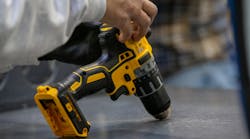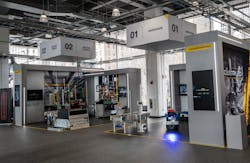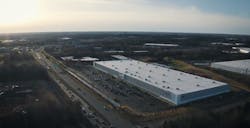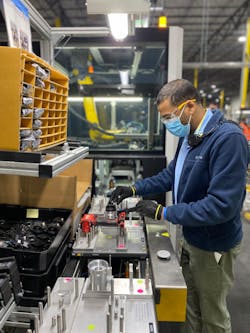Stanley Black & Decker Profits From Flexible Automation Cells
If SKU changeovers on a production line require tooling adjustments, purging and loading materials, or uploading new software instructions to robots to adjust the positions at which to drive screws, apply glue, make welds or perform other tasks, the sum total of these adjustments results in significant downtime. Conventional wisdom suggests it’s therefore more efficient to run multiple lines, each dedicated to a single SKU, rather than switch lines over.
Engineers at Stanley Black & Decker (SB&D) wondered whether this was necessarily true anymore, in the era of software-driven automation.
SB&D’s DeWalt, Craftsman and Stanley brand tools share very similar assembly steps. The primary differences between the lines consist of sub assembly components like motor systems and control modules that provide different strengths and torques. A line producing DeWalt brand drills could, with the right adjustments, just as easily produce Craftsman or Stanley brand drills.
The automotive sector has for decades produced different models of car on the same line by updating robot recipes. The aerospace industry employs giant, mobile robots that can manufacture different models of fuselage in the same facility, on the same line, via recipe updates.
If it works for the production of huge machines, thought engineers at SB&D, why can’t it work on a smaller scale?
Flexing Brains at The Manufactory
“When you think about a flexible automation cell, that doesn't mean that this one cell can do 10 different operations, rather think of it as a Lego brick,” says Eric Cowan, VP, Advanced Manufacturing. “When we design a flexible automation cell, our goal is to build a cell that will drive screws, and a different cell that will dispense glue, and another cell that will program or test or apply labels etc. Then it's about putting these together like Lego bricks, in order to build a production line.”
“We are able to basically have a line that essentially can handle maybe up to a dozen different SKUs,” says Mark Maybury, CTO. “Think of a dozen different drills that might go through that line where a new software program can be uploaded so the robots, the flexible cells, can flex, be modified to operate differently via that software control center.”
Jeffrey Miller, director of industrial high tech practice, digital performance management lead at Kalypso, a Rockwell Automation company (who is not involved with this project), says, “It’s not a revolutionary assemblage of technologies. The underlying technologies that allow you to load new program files for a work cell that has a certain envelope of functionality, like driving screws, or applying a glue line or fastening, around which the automation is built, that’s not new. The ability to do it across multiple work cells in a line, in an organized and orchestrated manner to reduce takt time in the aggregate, at the line level, that is innovative.”
The flexible automation cell technology addresses a historical foible of automation in manufacturing—building automated solutions for a task, then having to replace those solutions with new ones when the nature of the task changes.
“The difference in this approach is, we’re not saying we’re going to build an automated line to go make drills,” Cowan says. “We’re building a bunch of flexible automation cells… that you can reconfigure, so that when you change the product, next iteration cycle, I don’t have to throw this away and build a new [solution]. I just have to make some fixturing modifications.
“They make it cheaper in the long run to manufacture because I can take these cells and reconfigure them two years, three years down the line,” Cowan says. “Or if I need to, say, improve my cycle time, I can simply augment my line by adding additional cells. If in the next generation [of a tool] we add 50% more screws, I can either slow everything down or I can drop in one more flexible cell, and now my cycle time’s the same.”
Finding the Right Plant for the Job
“One of the comments that Craig Zielinski, director for power tools in North America at the time, he said ‘You know, this is one of the largest automation projects we’ve ever been able to do as a plant.’ And Don said something about ‘I’d love to see a fully automated drill line,” Cowan says.
In late 2019, Cowan’s team at the Manufactory worked on the Manufactory Cell or M-cell, an individualized platform for driving screws that could drop in over existing processes, that Cowan delivered in early 2020. When Maybury and Cowan demonstrated the M-cell screwdriver, upper management could imagine similar machines for gluing and labeling and other processes required to construct a full flexible cell line.
Cowan and his team worked with the Fort Mill plant to understand every process step on the drill manufacturing line and determine what automation solutions they would need on a cell-by-cell basis. The COVID-19 pandemic in 2020 and its effect on labor drove home the importance of the project.
Cowan and his team looked for manufacturing partners to build the cells and after a three-month search landed with Bright Machines, a company that had developed a similar, standardized cell. Bright Machines built the flexible automation cells for SB&D in Israel and delivered the first line, currently running at the Fort Mill facility, in late 2021.
The flexible automation cell line still requires human employees for materials changeovers and some assembly tasks. “If you think about a drill assembly, there are processes that are best done by a person, like the wire routing that has to happen before we close up the cell, with very tight constraints,” Cowan says. “While you could automate those tasks, the return or the value of automating those is a lot less.”
Training on the new line took days for operators and weeks for technicians, depending on how many skillsets employees had to build upon. “It’s important to upskill those people,” says Maybury . “It’s a different skill when somebody’s overseeing a flexible automation cell. There are some folks who may simply be feeding that cell. But there are others who are, designing, maintaining, and the like, that cell as well.”
“We’ve identified that we need in the positions that are interacting with these new lines… our highest quality of candidate,” says Brendan Pidgeon, plant manager at Fort Mill. “You’re not going to start your first day of your career here working on these lines. You’re going to work your way up, have demonstrated some aptitude, and I think [employees] have a great deal of pride that they get the opportunity to work on the line. We’re setting it up as an opportunity to work towards.
“Our materials team will purge any materials, (and) load said materials. But everything from screw driving, testing, soldering, labeling and even offloading the tools after they’re built to be transported? There’s prescribed recipes and things that say, ‘Hey, I know that I was making widget one. And now I’m making widget two. And I know how to handle that throughout the whole system,’” Pidgeon says. “It’s going to completely change the way that we operate and build high volume cordless tools out of this place.”
According to Pidgeon, a typical SKU change on the manual lines takes anywhere from 15 to 25 minutes, depending on the complexity. A more complex switchover on the manual lines can take between 30 and 45 minutes. Even when factoring the complexity of the SKU change, Pidgeon estimates that the flexible line can switch in 6-to-10 minutes.
Short-Term Results Suggest Long-Term Profits
The advantage of having the flexible automation cell installed next to the manual production lines in the Fort Mill plant, Maybury observes, is the ability to literally look back and forth and see the differences in how the lines operate.
When asked to quantify the performance of the flexible line, Maybury and Cowan say that 60% fewer workers can produce the same amount of product as a totally manual line with 20% faster takt time. The labor to staff a new injection molding section at Fort Mill for parts new to the plant will be available in part as a result of the four additional flexible automation cell lines arriving at the plant later this year.
The value of the ability to increase production, literally adding to the list of products manufactured at a single plant, without adding new workforce speaks for itself. What about the significance of a 20% reduction in takt time?
“In high volume repetitive manufacturing, if you can start knocking seconds and minutes out of inefficiencies… then these changes of technology really do bear fruit. They’re material in terms of the percentage increase in efficiencies they drive and thus the millions of dollars that they can save,” Kalypso’s Miller says.
“There's nothing magic about that [20%] ratio, but that’s pretty remarkable,” Miller adds. “I mean, that's a lot of money. I don't care what they’re manufacturing, that is a significant, huge potential savings or increase in efficiency. And if you convert it to additional capacity, that 20% faster takt time, never mind the labor cost reduction, I’ve got a double hit. I got more capacity on my line, which is monetizable, and my cost of per unit production has gone way down… It’s a win.”
Manufactory 4.0
· Location: Constitution Plaza, Hartford, Connecticut
· Size: 23,000 sq. ft.
· Named after the company’s first plant in Connecticut founded in 1843
· Hosts around 50 experts to work on advanced technologies
· Research is divided into four blocks: Shipping, assembly, machine tending, receiving
· The facility was recently scanned as part of a virtual tour project that will be released in the near future
Fort Mill Plant
· Also internally referred to as “Carolinas Manufacturing Operations”
· Size: 345,000 sq. ft.
· Approximately 650 workers
· Builds about 80,000-100,000 cordless tools per week, depending on the season
· DEWALT, Craftsman, and Mac brand tools are produced
· A tool comes off the line about every 35 seconds
· Approximately 500,000 individual components are used daily
Timeline
· Late 2019 - Executives tour the Fort Mill plant to observe an end-of-line palletization system, one of the largest automation projects SB&D has done at a plant. Then-CFO Don Allan says he’d love to see a fully-automated drill line.
· Later 2019 - Eric Cowan’s engineering team at Manufactory 4.0 in Hartford, Connecticut, works on the Manufactory Cell, or M-cell, an individualized platform for driving screws.
· Early 2020 - Cowan’s team delivers the M-cell. This demonstrates the flexible cell line principle and helps secure buy-in from upper management for the full line.
· After a three-to-four month long search, Bright Machines is named as the manufacturing partner for the flexible automation cell lines.
· Late 2021 - Bright Machines delivers the first complete line, composed of over a dozen flexible automation cells.
Expected in 2022 - Four additional flexible production lines, over 50 individual cells
About the Author
Dennis Scimeca
Dennis Scimeca is a veteran technology journalist with particular experience in vision system technology, machine learning/artificial intelligence, and augmented/mixed/virtual reality (XR), with bylines in consumer, developer, and B2B outlets.
At IndustryWeek, he covers the competitive advantages gained by manufacturers that deploy proven technologies. If you would like to share your story with IndustryWeek, please contact Dennis at [email protected].




